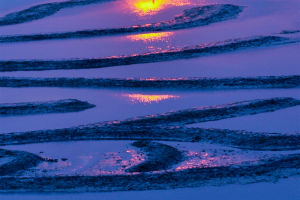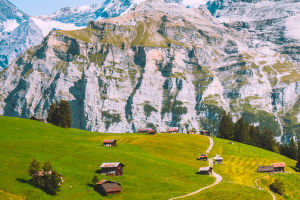Glacier Bay National Park is a breathtaking destination in Alaska's interior corridor that spans 3.3 million acres. It boasts rugged mountains, dynamic glaciers, temperate rainforests, wild coastlines, and deep bays.
The park is a part of the World Natural Heritage Site, which covers 25 million acres and is one of the largest international protected areas globally.
The St. Elias Mountains is a stunning range of rolling hills and mountains, and its high peaks hold back the moist air currents from the Pacific Ocean, allowing for extremely high snowfall, and creating a natural wonder of glaciers and snow-capped peaks.
When British navigator Vancouver arrived in the Icy Strait in 1794 on the Discovery, he did not witness Glacier Bay. Instead, he saw the end of a massive glacier - a 16-kilometre-long, 100-metre-high wall of ice.
However, when American naturalist John Muir arrived 85 years later, he discovered a vast bay, as the glacier had retracted 77 kilometres towards land.
Today, Glacier Bay National Park features an ice-eroded fjord that stretches a hundred kilometres inland along dense forests on either side, culminating in bare rock or one of the 16 glaciers that flow down from the US-Canada border range.
High peaks rise far above the horizon, overseeing the icy land that feeds the glaciers, the highest of which is Fairweather Peak at 4,670 metres.
The number of visitors flocking to McCarthy Way has been steadily increasing in recent years, from 5,000 in 1988 to over 25,000 in 1998.
However, only a small percentage of visitors travelling along McCarthy Road make it to the awe-inspiring backcountry of the park itself.
Most visitors are content to stay in McCarthy, which was once a sanctuary for Alaskan hermits and is now a tourist town.
Visitors can hike to nearby Kennicott and Root glaciers or take a 7km walk to the historic but now abandoned Kennicott Copper Camp.
However, the real treasure of the park is not in these roadside attractions, but in a wild and magnificent alpine world that Bob Jacobs referred to as "the mountains of North America."
The region boasts four major mountain ranges and six of the ten highest peaks in North America, including Mount St. Elias at 5,500 metres, and the Bagley Icefield, the largest near-polar ice field in North America.
It hosts a massive glacier system, including the Malaspina Reservoir River, which is even larger than Rhode Island, with rock walls standing for thousands of metres above glacier-carved gorges such as Chitistone and Nizina.
Low-lying coastal glaciers and peaks create a rugged and remote coastline. The park's alpine zone borders Kluane National Park in Canada.
Glacier Bay National Park offers visitors an incredible opportunity to experience nature's magnificence up close. From exploring the glaciers and snow-capped peaks to hiking through dense forests and observing diverse wildlife, the park has something for everyone.
It is essential to note that while the park is a popular tourist destination, visitors must respect the park's rules and regulations to preserve its natural beauty for future generations.
In addition to its natural wonders, Glacier Bay National Park has a rich history and culture. The Tlingit people have lived in the region for thousands of years and have a deep connection to the land and sea. Visitors can learn about their traditional ways of life and view their totem poles and other artefacts at the park's visitor centre.
The park also has a strong focus on conservation and sustainability. It is home to a diverse range of wildlife, including humpback whales, sea otters, bears, and eagles. Park rangers work to protect these animals and their habitats, while also promoting responsible tourism practices.
Visitors can explore the park in a variety of ways, including by boat, kayak, or on foot. Numerous hiking trails offer stunning views of the glaciers and mountains, as well as opportunities to spot wildlife. Those who prefer a more leisurely experience can take a boat tour and marvel at the beauty of the park from the water.
Glacier Bay National Park is an exceptional destination that should be on every nature lover's bucket list. With its stunning landscapes, dynamic glaciers, and diverse wildlife, the park is undoubtedly one of the most spectacular natural wonders in the world.


